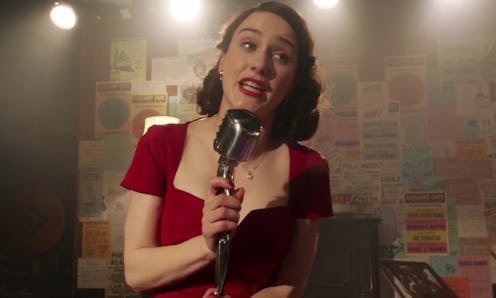Entertainment
How 'The Marvelous Mrs. Maisel' Set Made 1950s New York City Look Like A Candy-Colored Theater Production

The day before Amazon's new show The Marvelous Mrs. Maisel wrapped shooting Season 1, showrunner Amy Sherman-Palladino hadn't seen the set she was supposed to shoot on later that evening. The crew was scrambling to create an indoor set for an exterior scene that was supposed to be shot on location in New York earlier in the week, but had been canceled due to a during a freak lightning storm. As I discovered on a set visit with a few other writers earlier this fall, working quickly and scrappily to get things done is a requirement for everyone working on Maisel. It's an appropriately on-brand ethos for a series that looks and feels like theater, where die-hard enthusiasm and meticulous attention to detail are imperative both on stage and behind the scenes.
If you're familiar with Sherman-Palladino's previous work on Gilmore Girls and Bunheads, likening Maisel's vibe to theatre might not be particularly shocking. After all, the showrunner's other creations are as dialogue-heavy as stage plays, and often incorporate musical numbers into episodes. But Marvelous Mrs. Maisel's hyper-stylized set and production design, coupled with its colorful costumes and period setting, help make it feel like the most buoyant, theatrical Sherman-Palladino creation yet.
Despite the setback, the atmosphere on set was business as usual. Sherman-Palladino was out working on location with star Rachel Brosnahan a few miles from the studio, in an empty building that had been transformed into B. Altman's department store. (Production assistant Daniel Penrod told us that the show signed a year lease on the building so that they could leave the set up between seasons, a rare luxury for a television show made possible by the fact that Amazon has already greenlit Season Two.)
"Amy says, 'comedy is freezing,'" Gilbert relays to our group as a way of warning us that the studio will be chilly. That philosophy makes sense, if you think about Sherman-Palladino's signature fast-paced dialogue, which became synonymous with Gilmore Girls. Lower temperatures do create a sense of urgency, even if it's because you're shaking from the cold. We walked around costume store and the production offices, where Sherman-Palladino insisted on fresh flowers; her own office is decorated like a French salon peppered with Japanese animé. Yes, there is a hat rack in the hall.
Fans of Gilmore Girls are likely familiar with the Warner Brothers lot that "became" Stars Hollow, especially because its town square showed up in other shows like Pretty Little Liars. But unlike that lot, the Maisel studio is one gigantic room, with different characters' homes and offices hidden behind several doors, adding to the theatrical feel on set. On this particular day, half of the crew was setting up for an office Christmas party on one set, while the other half was finishing up that aforementioned exterior.
Everyone working behind the scenes seemed to be a character, too. We were eagerly ushered towards "Billy," AKA production designer Bill Groom, who gave us a tour around the various incredibly detailed sets in the studio.
Groom, who won four Emmy awards for his work on Boardwalk Empire, is delightfully self-deprecating about his success. "If you do enough velvet and enough fringe," he joked, "they give you an Emmy." He was also the Art Director for Saturday Night Live for four years in the '80s, which probably speaks to why the day's current emergency was no sweat.
Groom first showed us the Gaslight Café, which makes you feel plopped right into Inside Llewyn Davis — the 2013 film starring Oscar Isaac that uses the same former West Village coffee shop and performance space as a setting. From Susie's studio apartment that a person can barely squeeze into IRL to the fortune teller's office covered in peacock motifs, each set is transportive and theatrical.
Most everything seems practical, as well, which adds to the feeling that they're just putting on a show. There are a few uses of green screen for digital effects, but huge drapes printed with backdrops also hang from the rafters, ready to be wheeled in and peeked through a window. There's a subway set that's mechanically rigged to move. Groom says that he and his team went to the local museums for research, one of the many benefits to shooting a show set in New York City actually in New York City.
In the pilot we learn that Midge and her parents live in the same building in nearly identical apartments — but what the audience doesn't know is that it's actually the exact same set that gets redecorated. You can actually walk through it like a real apartment, from room to hallway. We imagined that crew members might take refuge up here for a quick nap on a long day — and Groom did not correct us.
The Marvelous Mrs. Maisel is about an upperclass woman out of her element, who finds a family in a scrappy group of performers. This is mirrored by the production in the best way: Yes, you can be scrappy, professional, and aesthetically gorgeous all at the same time. That's what theater is all about, and that's what Midge is all about, too.